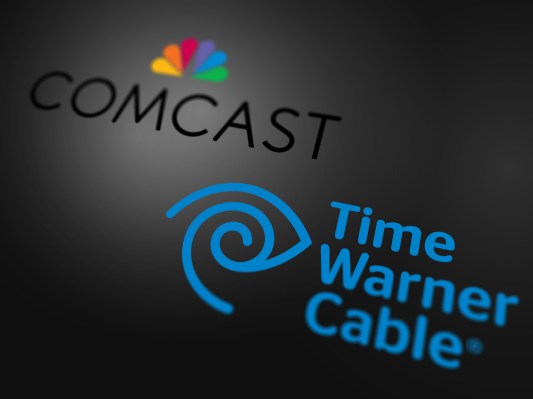A few months ago, Comcast announced its plans to purchase Time Warner Cable in one of the biggest acquisitions in the broadband or pay TV market. In a filing sent to the FCC and an extensive blog post today, Comcast made its pitch to government regulators, providing all the reasons that they should approve its latest massive acquisition.
The filing goes into great detail of all the consumer benefits that it expects to offer consumers based on its existing investments in broadband technologies, on-demand services, and streaming video, as well as the increased scale that comes from combining the two largest cable providers in the U.S.
Comcast’s Promises To Time Warner Cable Subscribers
According to Comcast, Time Warner Cable subscribers will benefit from faster broadband, better TV and streaming video offerings, an extensive on-demand video collection, and a wider selection of apps on a larger number of devices.
On the broadband front, Comcast touts faster speeds — the majority of its subscribers pay for 25 Mbps service, compared to 15 Mbps at Time Warner Cable. That’s due in part to its adoption of DOCSIS 3.1, which allows it to offer speeds of up to 505 Mbps.
Comcast also noted the wider availability of cable hotspots available in its service areas, with more than a million up and running today, compared to the 29,000 deployed by Time Warner Cable.
The company also says has a leg up on Time Warner Cable when it comes to video services — in particular, services that are available through apps on mobile and tablet devices. Comcast’s X1 is one of the more advanced cloud set-top box platforms available to pay TV providers, enabling better search and navigation than the traditional channel grid most subscribers are used to.
On the app front, Comcast’s Xfinity TV Go apps provide access to 300,000 on-demand offerings and 50 live streaming channels. It also offers 50,000 on-demand options through the set-top box, compared to the less than 20,000 that Time Warner Cable offers, as well as electronic sell-through options that allow subscribers to purchase movies instead of just renting them.
Comcast also says that it will extend the net neutrality protection it agreed to as part of its NBC Universal acquisition to Time Warner Cable subscribers. And it promises to offer its Internet Essentials program into Time Warner Cable markets.
All of this is actually a good thing, and most Time Warner Cable subscribers shouldn’t worry about Comcast taking over their service. If the acquisition is approved, the TV offerings, broadband access, and apps they’ll have access to will actually be better than what they have today.
The Competition — Or Lack Thereof
One of the big concerns about Comcast’s acquisition of Time Warner Cable revolves around the sheer size of the new combined entity, and what that will mean for the competition. Together, the companies will have about 30 million subscribers, which is nearly a third of the U.S. market.
Comcast has this to say about that:
It’s understandable why any large merger will attract questions about competition and consolidation. But this particular transaction actually raises few competition concerns.
Cable operators generally don’t compete against one another — instead, they are siloed into different geographical areas around the country. Whoever Time Warner Cable was competing with in any given market will still be there, so the consolidation doesn’t change market dynamics that much.
That said, competition in the pay TV market is fairly weak: DirecTV and Dish together would have a few million more subscribers than the combined Comcast-Time Warner Cable entity. And after investing billions to build out fiber-based video and broadband offerings, Verizon and AT&T have largely given up on the television market.
Broadband competition is even worse. Comcast and Time Warner Cable’s high-speed Internet services generally compete with DSL service from the local telco providers, which are generally much slower than the DOCSIS 3.1 technology that Comcast has rolled out.
Comcast points to the growing modern DSL market as competitive, since most DSL providers have upgraded networks to offer service that can reach 75 Mbps to 100 Mbps. That is still well below the speeds that Comcast touts in its consumer benefits pitch.
Meanwhile, despite some deployments by Google, alternative fiber offerings from other providers or municipalities are expensive and have been slow to roll out.
In its appeal to regulators, Comcast actually seeks to expand the competitive market to include Google, as well as companies like Amazon, Apple, Yahoo, and even Facebook. In its blog post, Comcast notes that it competes with Google in eight of nine Google Fiber deployments.
But it will be years or even decades before real fiber competition could show up, whether that comes from Google or anyone else.
Unanswered Questions
While it touted all the reasons why consumers would benefit from the acquisition, while also deflecting questions about the competitive environment, there were a few questions that Comcast didn’t address. Those deal specifically with the leverage that it will have over networks and other content providers, as well as what it could do over-the-top.
Comcast’s broadband scale make it a scary competitor to growing online video services like Netflix or Amazon’s Prime offering. The company alleviated some concerns with its commitment to net neutrality through the NBC Universal acquisition. But a recent transit deal with Netflix served as a reminder that there are costs for major content providers that seek to reach Comcast subscribers.
There’s also the question of Comcast’s own desire to go over-the-top itself. While the Time Warner Cable deal gives Comcast a huge amount of scale to reach tens of millions of broadband and video subscribers, all the work it’s done on the streaming side of things with apps means that it’s well-positioned to deploy its own over-the-top offering, if it ever wanted to. The question is, would it?
